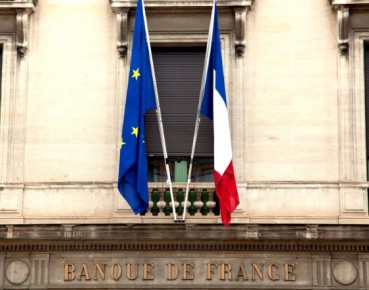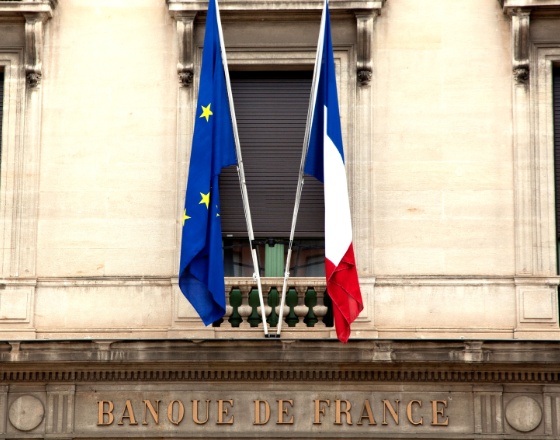
Banque de France (©PAP)
Russia’s invasion to Ukraine is a violation of the founding principles of the European and international order and undermines peace and stability in Europe. The latest IPCC report, despite being widely overshadowed by the war in Ukraine, has reminded us of another burning priority: climate change is accelerating and without immediate and deep emissions reductions in greenhouse gases, limiting global warming to 1.5°C will be beyond reach. Natural catastrophes such as droughts, heat waves, storms, etc. cost USD 250 billion in 2021, a steep increase of 24% compared with 2020 – which was already well above the 10-year average.
A critical moment
We are now at a critical moment for the climate, as the decisions we make now can secure a liveable future for the next generations. It is also a decisive turn for Europe as our dependence on fossil fuels is not only a danger to our planet, but is also increasingly a threat to national security. The European Union, in its Fit for 55 programme, has committed to ambitious carbon-cutting targets, with the aim of reducing its 1990 emissions levels by 55% by 2030, and of reaching net zero by 2050. It also aims at increasing the share of renewable energy in the European mix, which would reduce our dependence to fossil fuels. Today, however, the climate transition is clearly at risk of being overshadowed – and possibly delayed – by the war in Ukraine. The economic effects of the war have been immediate and severe, with soaring oil and gas prices pushing inflation rates in many countries to unprecedented levels since the 1980s. Russia’ invasion to Ukraine has precipitated a global energy crisis that has forced countries, especially in Europe, to look for ways to quickly wean themselves off Russian oil and gas, and reconsider timelines of commitments to cut the use of fossil fuels. The quickest measures to reduce Europe’s dependency on Russian gas could indeed result in some countries in an increased reliance on coal and oil.
Climate transition and the current surge in inflation
Central banks need to measure and assess the macroeconomic consequences of both the energy and the ecological transitions. To fulfil their price stability mandate, central banks need in particular to understand how these structural changes will impact inflation. The current increase in inflation is largely unrelated to climate transition as it has more to do with a combination of global factors: rapid recovery from the pandemic-induced recession, supply bottlenecks and the upward pressures on energy prices. The war in Ukraine has amplified even more the recent inflationary pressures and whereas we predicted beforehand that the inflation hump would gradually dissipate in 2022, the additional surge in commodity prices since end-February will delay this outlook. At the same time, the gradual switch to greener energies may also entail higher and more volatile prices, at least in the intermediate phase. The evidence has already pointed to some, although minor, direct contribution of climate policy in the recent increase in inflation in some countries. For instance, the implementation of a carbon tax in Germany in 2021, combined with other measures to tackle climate change, has had a discernible impact, as the overall impact on German consumer prices was estimated at 0.4 percentage point in 2021.
The debate about “greenflation”
Central banks are closely monitoring this debate about a possible “greenflation” and efforts are put into understanding the macroeconomics of climate, and how the transition could affect growth and price stability. The transition to a low-carbon economy can have macroeconomic impacts that could be particularly large with fast transition or unexpected policy changes. Such policies could trigger a rapid obsolescence of the capital stock and leave investments stranded. It could also trigger significant labour reallocation, skill obsolescence and job losses. Altogether, such developments could create challenges for policymakers to fulfil their macroeconomic stabilisation mandates. For central banks, although the transition can be seen as an adjustment of relative prices (with no impact on headline inflation in the long term), tensions on price stability might appear in the medium term due to the existence of frictions and phenomena of over-adjustment and amplification.
The transition involves a combination of supply and demand shocks whose total impact on inflation remains uncertain. We thus need a typology of potential shocks – demand and supply-driven – to correctly assess the implication of transition risks on price stability and growth. Some scenarios could have an inflationary impact, most notably in the event of a negative supply shock, especially a disorderly one. Higher costs following taxation or regulation, notably if they are introduced in an unexpected, delayed fashion, could indeed have inflationary impacts with downward pressures on economic activity. In the case of positive demand shocks, triggering for instance a boom in public or private investment in green assets, the inflationary impacts would go in tandem with higher growth. Conversely, disinflationary developments could arise in the event of heightened uncertainty or financial turmoil, due to stranded assets for example. Overall, the variety of shocks are likely to combine, amplifying or mitigating the aggregate impact. While it is most likely that some inflationary pressures might result from the transition, especially in energy prices, more research is now warranted to investigate further the macroeconomic impacts of the transition over horizons that are relevant for conceiving a range of potential stabilisation policies.
Finding a “path of compatibility”
In the light of the recent events, the consequences of transition policy on price stability have become more acute since there is a need to ensure continuous steps towards climate transition despite the ongoing energy crisis. The conflict in Ukraine shed light on the European dependency on Russian gas, which represents 45% of its gas imports. There is therefore an urgent need to accelerate the transition to renewable energy and find a “path of compatibility” that tackles the energy crisis and ensures our transition to a low-carbon economy. To do so, public and private stabilisers will prove to be useful resources to cushion the economic fallouts from the conflict, while providing the necessary resources to accelerate investments in sustainable activities. First, the Next Generation EU programme, which already dedicates 30% of its budget to the fight against climate change, should be boosted. But beyond this, private investment will be key: the EU happens to have the world’s greatest pool of savings – EUR 300 billion in excess savings – at its disposal. It is time to build the bridge between these financial resources and our energy investment needs, by finally achieving a genuine single financing market.
While the green transition does hold risks, it also offers economic and financial opportunities, as new technologies gradually reach scalability. The sooner we start, the more positive (or the less negative) the economic balance will be.
François Villeroy de Galhau, President of the Banque de France, Member of the Governing Council of the European Central Bank.
Stéphane Dees, Head of Climate Economics Unit, Banque de France.
The article is published in a series of articles in Obserwator Finansowy written by governors of central banks and distinguished economists. The series is under the special patronage of the Governor of Narodowy Bank Polski, Professor Adam Glapiński. The authors of the articles have agreed to waive their fees for writing the texts, and in exchange NBP shall donate the amount equivalent to the fees onto the account of the National Bank of Ukraine in order to support the NBU during the war. Below is a foreword by the Governor of NBP to the whole series:
On 24 February a huge tragedy occurred, in the face of which it is impossible to simply move on as if nothing had happened.
Nobody can remain indifferent to the misfortune that has befallen the Ukrainian nation.
All of us are shocked by the press reports, and particularly by what we see in the mass media.
Fighting Ukraine is not only its brave soldiers, but also an army of thousands of civilians trying to preserve normality in a country stricken by Russian aggression.
This army includes the staff of the National Bank of Ukraine, with whom NBP is in constant contact.
Aware of our Ukrainian colleagues’ needs, we have invited several central bank governors and eminent economists to share their knowledge on the economic processes taking place around the world.
It is rare for such a distinguished group of authors to feature in Obserwator Finansowy, which is published by NBP. It is also worth underlining that all the authors have waived the fees for their articles in order to donate them to meet the needs of our colleagues working in the National Bank of Ukraine.
I believe that you will find the series of these articles interesting, especially since they not only share the knowledge and experience of their authors, but also express goodwill towards the war-afflicted NBU.
Prof. Adam Glapiński, Governor of NBP


